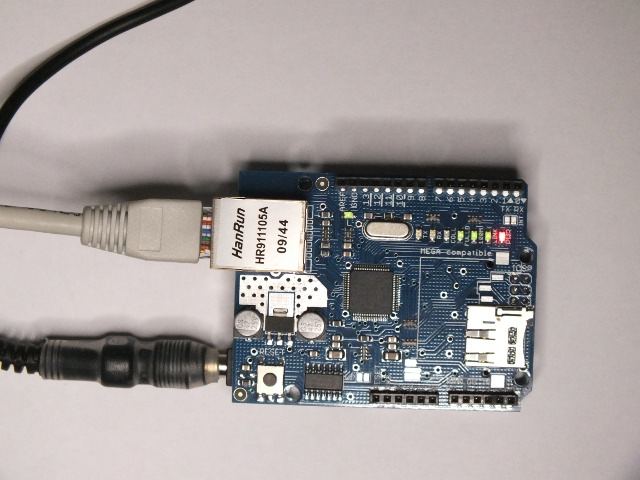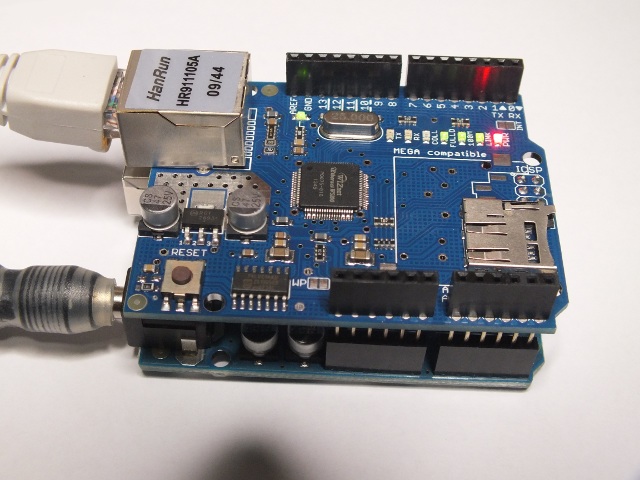The Arduino Ethernet Shield allows you to connects Arduino to your local LAN or Internet with Ethernet connection.. Just plug Arduino Ethernet Shield module onto your Arduino board, connect it to your network with an RJ45 cable. The original Arduino Ethernet Shield is based on the Wiznet W5100 Ethernet chip. Arduino IDE comes with example code. Everything else is good in The Arduino Ethernet Shield except the price which is typically in $30-45 range, which is expensive. This is why I have earlier used cheaper alternative Ethernet shield.
When the price gets right, I was ready to go to the original design. Now I found a very cheap Arduino Ethernet Shield: for € 6.12 ($8.15) I can buy Ethernet Shield Module W5100 Micro SD Card Slot For Arduino UNO MEGA. With this price it might not be worth to spend more time in trying to get cheaper alternatives to work.
Ethernet Shield Module W5100 Micro SD Card Slot For Arduino UNO MEGA is directly supported by Arduino official Ethernet Library. It comes with micro-SD card slot. The Wiznet W5100 provides a network (IP) stack capable of both TCP and UDP, supporting up to four simultaneous socket connections.
Ethernet Shield Module W5100 Micro SD Card Slot For Arduino UNO MEGA works well on Arduino UNO with WebServer example on Arduino IDE 1.0.5. Thing worked well as expected. This card seems to be well worth of the price. It had the features I wanted (Ethernet connection) in the price range I liked.
I have not had time to test other applications for this Ethernet shied. Here are some interesting looking things I might plan to try: ArduinoCommander controlling, Pin Control Over the Internet – Arduino + Ethernet and RESTduino – Arduino hacking for the REST of us.


4 Comments
Tomi Engdahl says:
Here is example of potential EMC problems with Ethernet shield:
Home> Community > Blogs > The EMC Blog
Beware of hidden antennas!
http://www.edn.com/electronics-blogs/the-emc-blog/4439771/Beware-of-hidden-antennas-
There are many causes of radiated emissions and the product designer needs to be able to identify the “hidden antennas” that cause this.
An important concept to grasp is the electrical dimension of an electromagnetic radiating structure. EMC engineers often call any radiator of electromagnetic energy an “antenna,” whether it is an actual antenna or another radiator, such as a cable or circuit-board trace.
Figure 1 – An example where two PC bards form a “hidden dipole”. I’m using a Rohde & Schwarz RT-ZD10 1 GHz differential probe to measure the voltage between the connector ground shells of two boards. If the boards are bonded together well enough, the voltage should read zero.
These dipole structures could include:
• Cables (I/O or power)
• PC boards with attached cables
• Seams/slots in shielded enclosures as they approach 1/2 λ
• Apertures in enclosures as they approach 1/2 λ
• Poorly bonded sheet metal (of enclosures)
• Internal interconnect cables
• Peripheral equipment connected to the equipment under test (EUT)
For example, as a cable or slot approaches 1/2-wavelength (or a multiple) at the frequency of concern, it becomes an efficient transmitting or receiving antenna for interference. To reduce the antenna currents (common-mode currents) on these structures, the solution might be to install ferrite chokes or filters on cables and seal up slots in enclosure seams.
As the structures approach the resonant length of a dipole, their antenna properties become more efficient.
Tomi Engdahl says:
https://learn.adafruit.com/arduino-ethernet-sd-card?view=all
Tomi Engdahl says:
Simple Webserver with Arduino Ethernet Shield
https://www.elithecomputerguy.com/2019/08/simple-webserver-with-arduino-ethernet-shield/
shadin says:
Nice article about Arduino